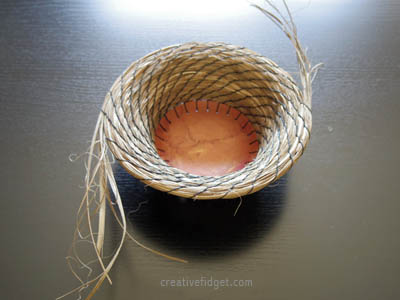When I was a child my mother added basket-making to the seemingly endless list of crafts she had tried. My Dad took one of her cute garlic baskets to work and came home with an order for 99 of them. By the end Mum’s hands were a painful mess and the gloss had thoroughly worn off basketry as a hobby.
It was the first warning I had not to turn hobbies into work. Not that I listened, having worked as an illustrator and now earning a living as a writer.
When I saw that the Handweavers and Spinners Guild had a one-day basketry class in their summer school schedule, I decided to sign up. I’ve been a bit wary of cane basketry, because I’ve heard it’s a bit hard on the hands. But these were coiled baskets, which involves stitching materials into place not wrestling them into a weave. I like the idea that I could use plant materials from the garden rather than much harder cane.
Well, it was great fun. We started with polymer clay bases, as starting is the hardest and slowest part. We used cordyline (cabbage tree) leaves, which I have the red version of in the garden, and stitched it all together with waxed linen thread.

I finished it by leaving some leaves sprouting from the rim, adding another bunch and sewed around to the opposite side before finishing off, leaving another tuft of leaves.
You can use this method with other long, flexible materials, like rags and rope. I have a pile of old garden hoses. I’m thinking of using a plant pot drip tray as the base, and sewing it all together with wire or heavy plastic twine.
But I do love the idea of using plants from the garden. I’ve already got some of the recommended plants growing here: cordyline, lomandra longifolia, dianella, lavender and aram lily. I already planned to grow red hot poker. Maybe I can find a place for New Zealand flax and canna lilies as well.
